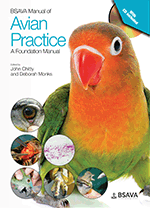
Full text loading...

The first section of this chapter, on hospital setup for birds, covers emergency and hospital equipment, pharmacy, cages, biosecurity, heating, hospital treatment room setup for birds, feeding and nutrition of hospitalized birds. The second section, on emergency and critical care, covers hypothermia, fluid therapy, nutritional support, emergency medications, oxygen supplementation and air sac tube placement. The third section covers the specific emergencies of burns, oil contamination, hyperthermia, haemorrhage and animal bites, with guidance on when to perform blood transfusion and cardiopulmonary resuscitation.
Hospitalization and basic critical care, Page 1 of 1
< Previous page | Next page > /docserver/preview/fulltext/10.22233/9781910443323/9781910443323.11-1.gif

Full text loading...






























